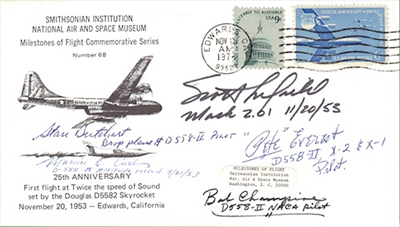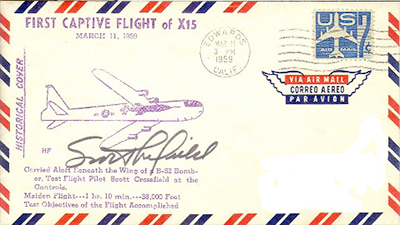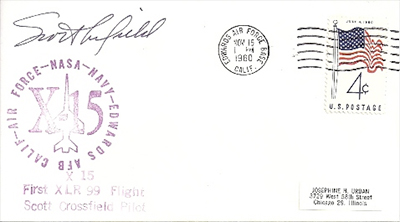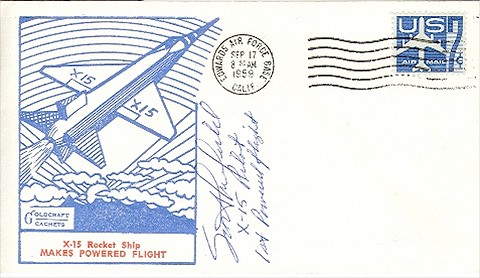Space Cover #207: Scott CrossfieldThis cover was postmarked at Edwards AFB on September 17, 1959, the date of the first powered flight of the X-15 rocketplane, where it happened. The cachet is by George Goldey, and the cover has been autographed and inscribed by the pilot, Scott Crossfield. This was the flight that Crossfield had worked many years to perform - more on that later.
Since we've already looked at X-15 pilots McKay (Space Cover 80), Petersen (Space Cover 143), Bob White (Space Cover 165), and Walker (Space Cover 196), I figured it was high time to look at the first X-15 pilot, Scott Crossfield. Crossfield became a Navy flight instructor in 1943 and continued after the war while he earned a graduate degree in Aeronautical Sciences in 1950. In 1950 he joined NACA (NASA's predecessor) as a test pilot and flew almost all of the jet-powered and rocket-powered aircraft in test at that time. His most notable achievement at NACA was the first-ever flight to exceed twice the speed of sound (Mach 2) on November 20, 1953, flying the rocket powered D-558-II Skyrocket. There are no covers known to have been postmarked on that flight date, but the Smithsonian did issue a great 25th anniversary cover in their "Milestones of Flight" series (below).

This is the Milestones of Flight #68 cover, postmarked at Edwards on the 25th Anniversary of Crossfield's Mach 2 flight. Crossfield has autographed right below the stamps. And just for the record, the other autographs are some of Crossfield's fellow Skyrocket pilots (clockwise from below Crossfield): Pete Everest, Bob Champine, Marion Carl, and Stan Butchart.
In 1955, Crossfield left NACA to work for North American Aviation as it developed the next generation rocketplane - the X-15. He worked develop many of the X-15 systems while waiting to perform the first flights. Finally, on March 10, 1959, the X-15 was carried aloft by its B-52 mother plane for a "captive" test flight with Crossfield in the cockpit (Howard Farley printed cachet cover below, postmarked the day after, and autographed by Crossfield).

It took several more captive flights and a glide flight to finally work up to the first X-15 powered flight on September 17 (the cover at top). The big engine that was intended to power the X-15 was not ready for the flight, so two smaller engines that had originally powered the X-1 rocketplane were used. Crossfield kept the first powered flight low (53,000 feet) and slow (Mach 2.11), at least by X-15 standards.
He flew nine more flights of the X-15 with the interim engines, and survived the explosion of one of the "big" engines in a June 17, 1960 ground test. Finally on November 15, 1960, Crossfield piloted the first flight of the X-15 with the "big" engine (Boy Scout Cachet with November 15, 1960 Edwards AFB postmark and Crossfield autograph below).

Crossfield performed two more X-15 flights on November 22 and December 6, 1960, then the X-15 was handed over to the NASA/Air Force/Navy pilot team to push it to its limits. Crossfield left the program, having flown the X-15 a total of 14 times. He went on to several management and engineering positions in the aerospace industry.
Crossfield's autobiography, Always Another Dawn, first published in 1960 is considered one of the best books by the rocketplane pilots. In 2003, in a total departure from his jet and rocket flights, he test flew an exact replica of the 1903 Wright Flyer as part of the Centennial of Flight. On April 19, 2006, Scott Crossfield was caught in severe weather in his Cessna personal airplane and was killed when it flew into a hillside. He was always kind to us "ground-pounders" who hounded him with questions and autograph requests. May he rest in peace...
















